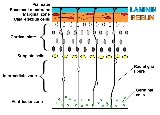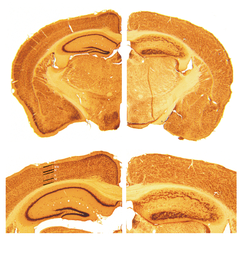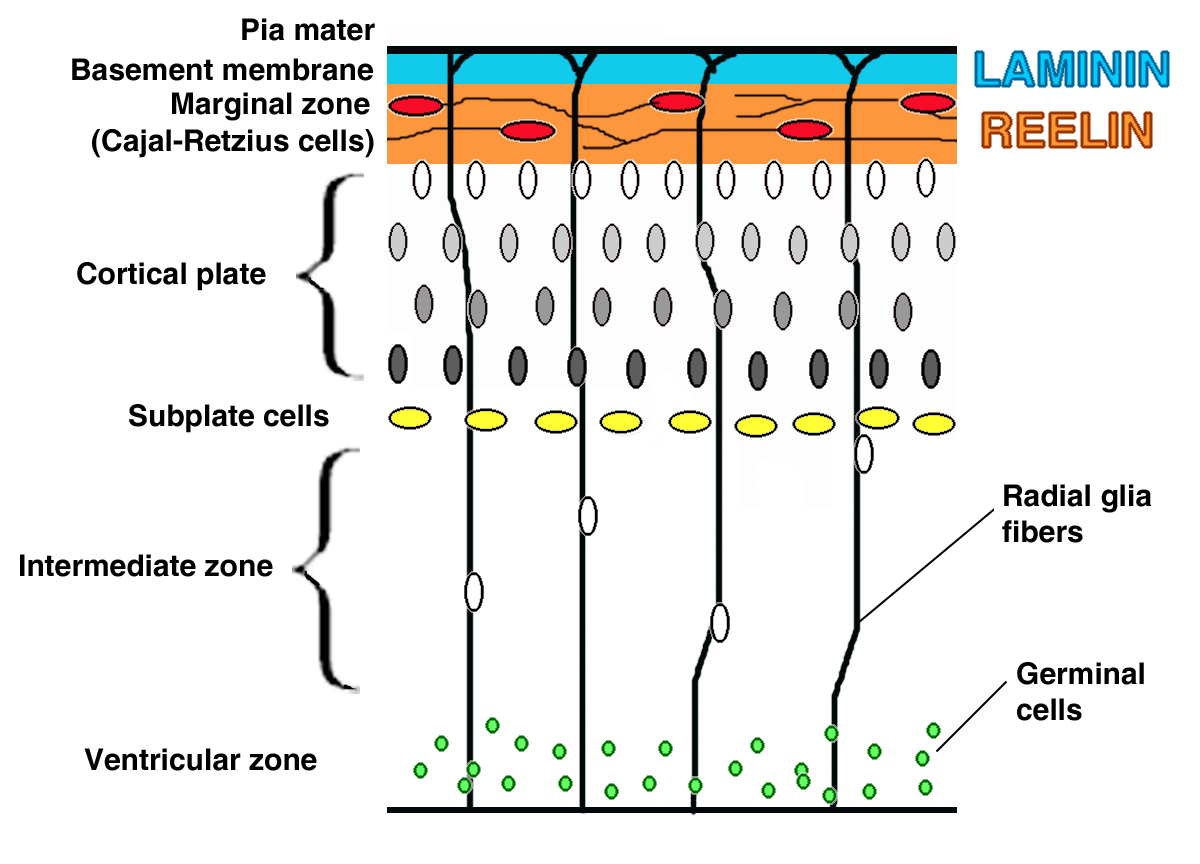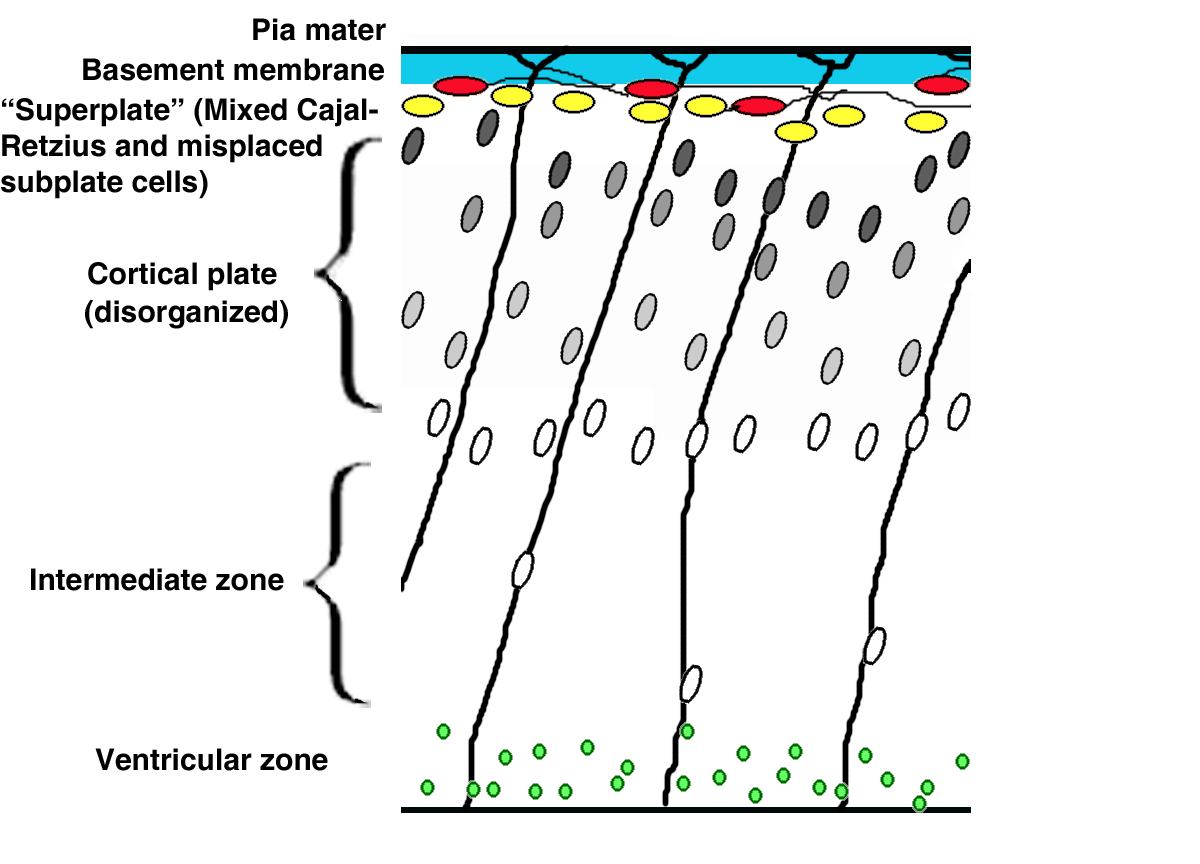
Reeler
Encyclopedia
A reeler is a mouse
Mouse
A mouse is a small mammal belonging to the order of rodents. The best known mouse species is the common house mouse . It is also a popular pet. In some places, certain kinds of field mice are also common. This rodent is eaten by large birds such as hawks and eagles...
mutant
Mutant
In biology and especially genetics, a mutant is an individual, organism, or new genetic character, arising or resulting from an instance of mutation, which is a base-pair sequence change within the DNA of a gene or chromosome of an organism resulting in the creation of a new character or trait not...
, so named because of its characteristic "reeling" gait
Gait
Gait is the pattern of movement of the limbs of animals, including humans, during locomotion over a solid substrate. Most animals use a variety of gaits, selecting gait based on speed, terrain, the need to maneuver, and energetic efficiency...
. This is caused by profound hypoplasia
Hypoplasia
Hypoplasia is underdevelopment or incomplete development of a tissue or organ. Although the term is not always used precisely, it properly refers to an inadequate or below-normal number of cells. Hypoplasia is similar to aplasia, but less severe. It is technically not the opposite of hyperplasia...
of the mouse's cerebellum
Cerebellum
The cerebellum is a region of the brain that plays an important role in motor control. It may also be involved in some cognitive functions such as attention and language, and in regulating fear and pleasure responses, but its movement-related functions are the most solidly established...
, in which the normal cerebellar folia
Folium (brain)
A folium is a wrinkle on the surface of the cerebellum. The cortex of a folium consists of three layers of cells - the top molecular layer, the Purkinje layer, and the bottom granular layer - and this cortex covers deeper white matter ....
are missing. The mutation is autosomal and recessive
Recessive
In genetics, the term "recessive gene" refers to an allele that causes a phenotype that is only seen in a homozygous genotype and never in a heterozygous genotype. Every person has two copies of every gene on autosomal chromosomes, one from mother and one from father...
.
Cortical neurons are generated normally but are abnormally placed, resulting in disorganization of cortical laminar layers in the CNS. The reason is the lack of Reelin
Reelin
Reelin is a large secreted extracellular matrix protein that helps regulate processes of neuronal migration and positioning in the developing brain by controlling cell–cell interactions. Besides this important role in early development, reelin continues to work in the adult brain. It modulates the...
, an extracellular matrix
Extracellular matrix
In biology, the extracellular matrix is the extracellular part of animal tissue that usually provides structural support to the animal cells in addition to performing various other important functions. The extracellular matrix is the defining feature of connective tissue in animals.Extracellular...
glycoprotein
Glycoprotein
Glycoproteins are proteins that contain oligosaccharide chains covalently attached to polypeptide side-chains. The carbohydrate is attached to the protein in a cotranslational or posttranslational modification. This process is known as glycosylation. In proteins that have segments extending...
, which during the corticogenesis is secreted mainly by the Cajal-Retzius cell
Cajal-Retzius cell
The term Cajal–Retzius cell is applied to reelin-producing neurons of the human embryonic marginal zone which display, as a salient feature, radial ascending processes that contact the pial surface, and a horizontal axon plexus located in the deep marginal zone...
s.
In the reeler neocortex, cortical plate neurons are aligned in a practically inverted fashion (‘‘outside-in’’). In the ventricular zone of the cortex fewer neurons have been found to have radial glial processes. In the dentate gyrus
Dentate gyrus
The dentate gyrus is part of the hippocampal formation. It is thought to contribute to new memories as well as other functional roles. It is notable as being one of a select few brain structures currently known to have high rates of neurogenesis in adult rats, .The dentate gyrus cells receive...
of hippocampus
Hippocampus
The hippocampus is a major component of the brains of humans and other vertebrates. It belongs to the limbic system and plays important roles in the consolidation of information from short-term memory to long-term memory and spatial navigation. Humans and other mammals have two hippocampi, one in...
, no characteristic radial glial scaffold is formed and no compact granule cell
Granule cell
In neuroscience, granule cells refer to tiny neurons that are around 10 micrometres in diameter. Granule cells are found within the granular layer of the cerebellum , the dentate gyrus of the...
layer is established. Therefore, the reeler mouse presents a good model in which to investigate the mechanisms of establishment of the precise neuronal network during development.
Types of reelers
There are two types of the reeler mutation:- Albany2 mutation (Reln(rl-Alb2)
- Orleans mutation (Reln-rl-orl, or rl-orl), in which reelin lacks a C-terminal region and a part of the eighth reelin repeat. This hampers the secretion of the protein from the cell.
In order to unravel the reelin signaling chain, attempts are made to cut the signal downstream of reelin, leaving reelin expression intact but creating the reeler phenotype
Phenotype
A phenotype is an organism's observable characteristics or traits: such as its morphology, development, biochemical or physiological properties, behavior, and products of behavior...
, sometimes a partial phenotype, thus confirming the role of downstream molecules. The examples include:
- Double knockout of VLDLR and ApoER2 receptors;
- Double knockout of SrcSrc (gene)Proto-oncogene tyrosine-protein kinase Src is an enzyme that in humans is encoded by the SRC gene.Src is a proto-oncogene encoding a tyrosine kinase originally discovered by J. Michael Bishop and Harold E. Varmus, for which they won the 1989 Nobel Prize in Physiology or Medicine. It belongs to a...
and FynFYNProto-oncogene tyrosine-protein kinase Fyn is an enzyme that in humans is encoded by the FYN gene.This gene is a member of the protein-tyrosine kinase oncogene family. It encodes a membrane-associated tyrosine kinase that has been implicated in the control of cell growth...
kinases. - Cre-loxP recombinationCre-Lox recombinationCre-Lox recombination is a special type of site-specific recombination developed by Dr. Brian Sauer initially for use in activating gene expression in mammalian cell lines and transgenic mice . Subsequently, the laboratory of Dr...
mice model that lacks CrkCRK (gene)Adapter molecule crk also known as proto-oncogene c-Crk or p38 is a protein that in humans is encoded by the CRK gene.- Function :...
and CrkLCRKLCrk-like protein is a protein that in humans is encoded by the CRKL gene.CrkL together with Crk participates in the Reelin signaling cascade downstream of DAB1.-Interactions:...
in most neurons. Was used to show that Crk/CrkL lie downstream of DAB1] in the reelin signaling pathway. - Scrambler mouseScrambler mouseScrambler is a spontaneous mouse mutant lacking a functional DAB1 gene, resulting in a phenotype resembling that seen in the reeler mouse. The strain was first described by Sweet et al in 1996.-Neuroanatomical abnormalities:...

Key pathological findings in the Reeler brain structure


- Inversion of cortical layers.
- SubplateSubplateThe transient fetal subplate zone, together with the marginal zone and the cortical plate, represents the developmental anlage of the mammalian cerebral cortex...
cells become abnormally located in the subpial zone above the cortical plate. This hampers their function in establishing the transient circuits between the incoming thalamicThalamusThe thalamus is a midline paired symmetrical structure within the brains of vertebrates, including humans. It is situated between the cerebral cortex and midbrain, both in terms of location and neurological connections...
axons and layer IV cells of the cortical plate. Thalamic axons have to grow past the cortical plate to reach the mispositioned subplate cells in the so-called superplate and then turn back down to contact their appropriate targets. This creates a curious "looping" thalamocortical connection seen in the adult reeler brain.
- Subplate
- Dispersion of neurons within cortical layers.
- Decreased cerebellarCerebellumThe cerebellum is a region of the brain that plays an important role in motor control. It may also be involved in some cognitive functions such as attention and language, and in regulating fear and pleasure responses, but its movement-related functions are the most solidly established...
size. - Failure of preplate to split
- Failure to establish a distinct granule cell layer in the dentate gyrus. Normal dentate gyrus demonstrates a clear segregation of granule cells and hilar mossy cells, which are identified, respectively, by their expression of calbindinCalbindinCalbindin refers to several calcium-binding proteins. They were originally described as vitamin D-dependent calcium-binding proteins in the intestine and kidney in the chick and mammals...
and calretininCalretininCalretinin also known as 29 kDa calbindin is a vitamin D-dependent calcium-binding protein involved in calcium signaling. In humans, the calretinin protein is encoded by the CALB2 gene.- Function :...
. In the reeler DG, the two cell types intermingle. - Impaired dendrite outgrowth.
- In one study, reeler mice were shown to have attenuated methamphetamine-induced hyperlocomotion, which was also reduced by a targeted disruption of reelin activity in wildtype mice. Reeler mice in the same study demonstrated a decrease in D1 and D2 receptor-mediated dopaminergic function together with reduced numbers of D1\D2 receptors.
Heterozygous Reeler Mouse
Heterozygous reeler mice, also known as HRM, while lacking the apparent phenotype seen in the homozygous reeler, also show some brain abnormalities due to the reelin deficit.Heterozygous (rl/+) mice express reelin at 50% of wild-type levels and have grossly normal brains but exhibit a progressive loss during aging of a neuronal target of reelin action, Purkinje cell
Purkinje cell
For the cells of the electrical conduction system of the heart, see Purkinje fibersPurkinje cells, or Purkinje neurons , are a class of GABAergic neurons located in the cerebellar cortex...
s.
The mice have reduced density of parvalbumin
Parvalbumin
Parvalbumin is a calcium-binding albumin protein with low molecular weight .It has three EF hand motifs and is structurally related to calmodulin and troponin C...
-containing interneuron
Interneuron
An interneuron is a multipolar neuron which connects afferent neurons and efferent neurons in neural pathways...
s in circumscribed regions of striatum
Striatum
The striatum, also known as the neostriatum or striate nucleus, is a subcortical part of the forebrain. It is the major input station of the basal ganglia system. The striatum, in turn, gets input from the cerebral cortex...
, according to one study.
Studies reveal a 16% deficit in the number of Purkinje cells in 3-month-old (+/rl) and a 24% one in 16-month-old animals: surprisingly this deficit is only present in the (+/rl) males, while the females are spared.
History of research
First mention of reeler mouse mutation dates back to 1951. In the later years, histopathological studies revealed that the reeler cerebellum is dramatically decreased in size and the normal laminar organization found in several brain regions is disrupted (Hamburgh, 1960). In 1995, the RELN gene and reelinReelin
Reelin is a large secreted extracellular matrix protein that helps regulate processes of neuronal migration and positioning in the developing brain by controlling cell–cell interactions. Besides this important role in early development, reelin continues to work in the adult brain. It modulates the...
protein were discovered at chromosome 7q22 by Tom Curran and colleagues.
See also
- Shaking rat Kawasaki has a reduced reelin expression due to missplicing of the reelin gene.
- Sticky mouse
External links
- Development of the Cerebral Cortex: III. The Reeler Mutation - by Paul J. Lombroso, M.D.

